
Welcome to the breathtaking Perito Moreno Glacier, one of Argentina’s most famous tourist attractions! The glacier is located in the Los Glaciares National Park and
Rio de Janeiro, also known as the „Marvelous City,“ is a place that never fails to impress. It is a bustling metropolis with a unique blend of history, culture, and nature. The city is home to some of the most famous landmarks in Brazil, including the Christ the Redeemer statue, Sugarloaf Mountain, and Copacabana Beach. But Rio de Janeiro has much more to offer than just these tourist hotspots. After exploring all the hidden gems it has to offer, we’re excited to share our top seven must-visit sights with you!

The Christ the Redeemer statue (Cristo Redentor) in Rio de Janeiro’s most iconic landmark and a must-visit sight for any traveler. The statue stands tall at 98 feet and overlooks the city from the top of Corcovado Mountain. The view from the statue is breathtaking, and the experience of seeing it up close is unforgettable.
To get to the Christ the Redeemer statue, you can take a train or van from the base of Corcovado Mountain. The train journey is a unique experience that takes you through the Tijuca Forest, one of the largest urban forests in the world. The van ride is a bit quicker and less expensive, but the train journey is more scenic and provides a better overall experience. It will cost you 16,70€/18$ for a return train ticket and the entrance fee to the statue.
Insider Tip: The best time to visit the Christ the Redeemer statue is early in the morning or late in the afternoon when there are fewer crowds. It is also a good idea to check the weather forecast before you go, as the view from the statue can be obstructed on cloudy days.
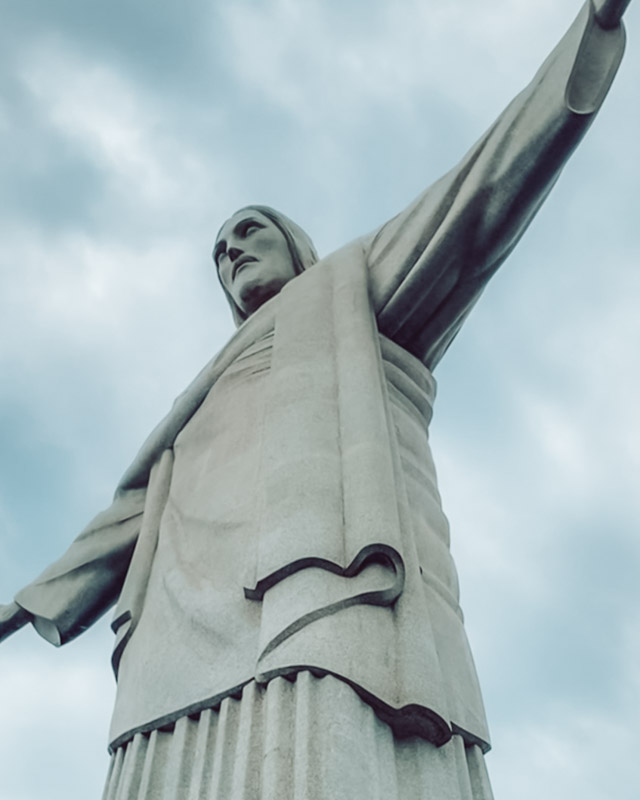

Sugarloaf Mountain („Pão de Açúcar“) is another iconic landmark in Rio de Janeiro that offers stunning views of the city. The mountain is named after its shape, which resembles a traditional shape of sugar used in Portuguese cooking. It was already built in 1912/1913 and you’ll have a stunning view over Copacabana, the city center, and even the Christ statue.
To get to Sugarloaf Mountain, you can take a cable car ride from Praia Vermelha. The cable car ride is divided into two stages, with a stop at Morro da Urca before reaching the top of Sugarloaf Mountain. The ride itself is an experience that offers spectacular views of Rio de Janeiro. The ticket cost around 19€/21$.
The best time to visit Sugarloaf Mountain is in the late afternoon, so you can watch the sunset over the city. Also, try to avoid visiting on weekends or holidays when it’s very busy and queues can be very long at that time.
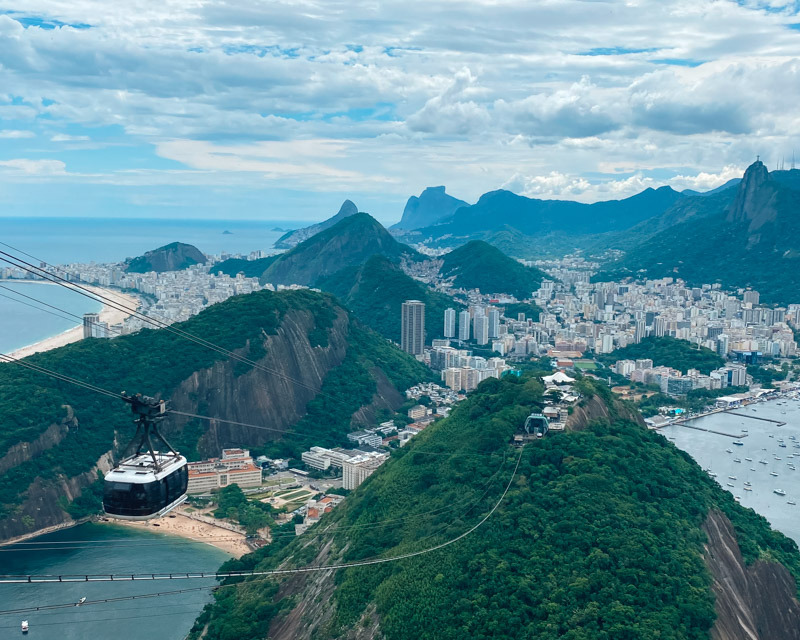
Copacabana Beach is one of the most famous beaches in the world for a good reason. The four-kilometer stretch of sand and surf is a perfect place to relax, people-watch, and soak up the sun. The beach is lined with restaurants, bars, and shops, making it a great place to spend the day.
Copacabana Beach is located in the South Zone of Rio de Janeiro and is easily accessible by bus or taxi. The beach is also within walking distance of many of the city’s hotels and hostels.
If you want to avoid the crowds at Copacabana Beach, consider visiting early in the morning or late in the afternoon. You can also rent a beach chair and umbrella from one of the many vendors along the beach. Also on the weekends, it can get very crowded as all the families gather there for their days off.


Ipanema Beach is another popular beach in Rio de Janeiro and is known for its stunning sunsets and lively atmosphere. The beach is located in the upscale neighborhood of Ipanema and is a great place to surf, swim, or relax.
Ipanema Beach is located in the South Zone of Rio de Janeiro and is easily accessible by bus or taxi. The beach is also within walking distance of many of the city’s hotels and hostels.
If you’re looking for a quieter experience, head to Arpoador, a small beach between Ipanema and Copacabana. It’s a great place to watch the sunset and is less crowded than the other beaches in the area.

Santa Teresa is a bohemian neighborhood in Rio de Janeiro that is known for its narrow streets, historic mansions, and vibrant street art. The neighborhood is a great place to explore on foot and is home to several art galleries, restaurants, and bars.
Santa Teresa is located in the central area of Rio de Janeiro and is easily accessible by bus or taxi. You can also take the famous tram, known as the Bonde de Santa Teresa, which runs through the neighborhood. The trams used to run through the whole city in the past but now there’s only one line left. Start your tour at Estação de Bondes de Santa Teresa in the center. The return ticket is around 3,10€. Also, the waiting line can be pretty long on the weekends or public holidays.
We don’t recommend going on Saturday or Sunday as the city center is completely empty and it can be dangerous. Nevertheless, we did a free walking tour with Rio by foot through the Historic center on a Saturday. It covers sights like Theatro Municipal do Rio de Janeiro, Confiteria Colombo, or Praça XV de Novembro.
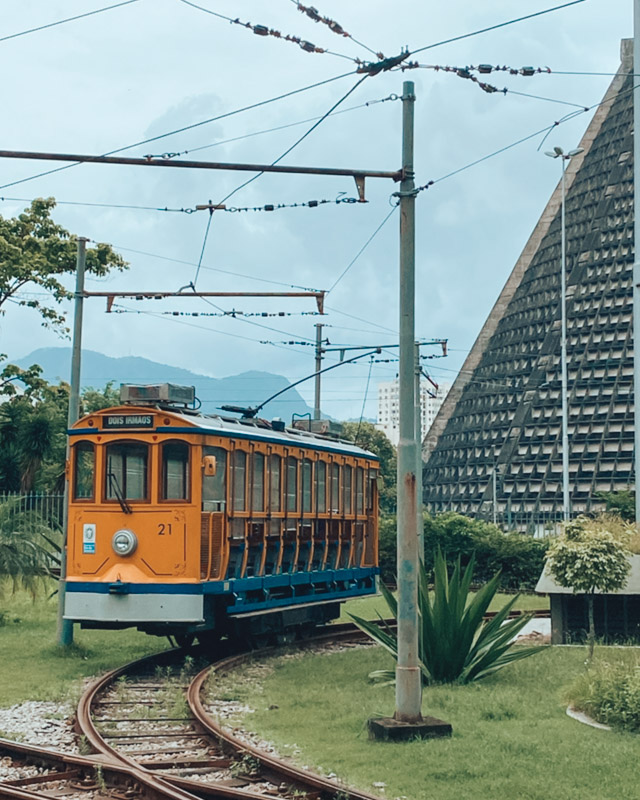

If you’re visiting Santa Teresa, be sure to check out the Selaron steps. The colorful staircase is a work of art with features over 2000 tiles from over 60 countries. It marks the border between Lapa and Santa Teresa and is one of the most lively and prominent landmarks in Rio. It’s a great spot for a photo shoot, although it can be crowded!
On the foot of the stairs are some nice local restaurants to have a cold beer and escape the crowds for a while. One of them is Os Ximenes which has fair prices and even German beer.
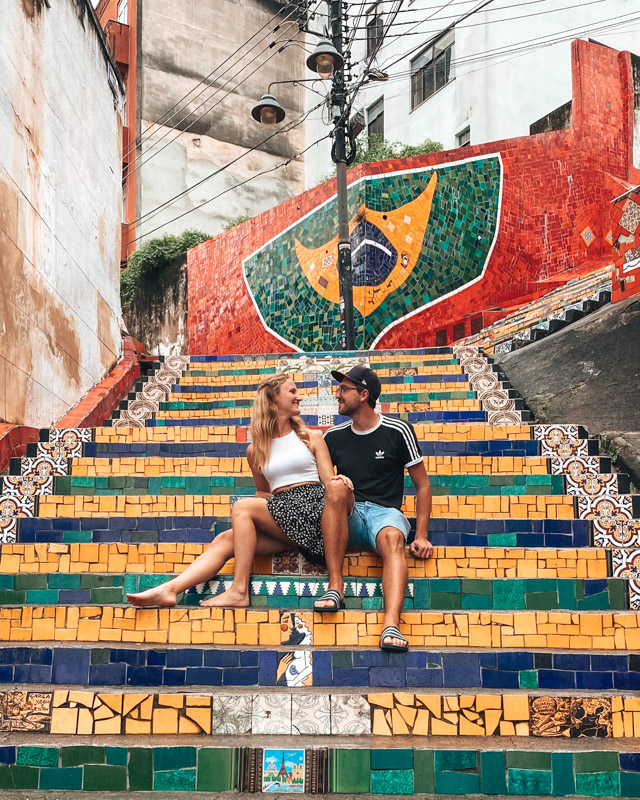

Get up early as the drive to Pedra do Telegraph takes about 90 minutes from the Copacabana area. Once you arrived there, you’ll have to hike for another 50 minutes to get to the famous rock. So be sure to take enough water with you.
We were a bit late, so there was already a queue of people who wanted to take pictures. We had to wait for 45 minutes to get that famous shot. There’s also a photographer who offers to take pictures for you for a small fee.
On the way back you can stop at one of the beaches to cool off again. We shared a car with another couple and paid 12,70€ back and forth.


Rio de Janeiro can be a dangerous city with its dozens of favelas and a high crime rate. But don’t be afraid. You will be safe when you keep your common sense and behave reasonably. The best areas to stay in Rio are Copacabana, Ipanema, or Leblon. You’ll find hundreds of accommodations from low-budget hostels to luxury resorts. Good options in Rio de Janeiro include the Selina Copacabana (close to Copacabana beach and beautiful rooms), Pura Vida Hostel (good location between Ipanema and Copacabana), and Tiny Studio Nation Copacabana (close to the beach and to the Metro). In total, we stayed 10 nights in Rio de Janeiro at two different accommodations in Copacabana.
We stayed at an apartment for a week (Airbnb) and another 3 nights in CLH Suites, which is located just behind the famous Copacabana beach road. We paid 20€ per person and night which is a fair price when considering the perfect location. It’s safe to walk around, even at night. But be aware of pickpockets as our beach bag got stolen at Copacabana beach.
Next to the thousand accommodations you will find even more food choices around these touristy areas. We can recommend Sushi Akyrio, Zagga Pizza bar and Papa Jack (both Italian), Caju Gastrobar (drinks and burgers), Oakberry Acai (breakfast/snack), and Bibi Sucos (everything).


Lapa is a historic neighborhood in Rio de Janeiro that is known for its vibrant nightlife and colorful architecture. The neighborhood is home to several bars, clubs, and restaurants, making it a popular spot for locals and tourists alike.
Lapa is located in the downtown area of Rio de Janeiro and is easily accessible by bus or taxi. The neighborhood is also within walking distance of many of the city’s hotels and hostels.
If you’re visiting Lapa at night, be sure to take a walk on the Arcos da Lapa, a series of arches that date back to the 18th century. The arches are illuminated at night, creating a stunning backdrop for a night out.
Maracanã Stadium is one of the most iconic sports stadiums in the world and is home to the Brazilian national football team. The stadium has hosted several major sporting events, including the 1950 FIFA World Cup and the 2016 Summer Olympics.
Maracanã Stadium is located in the North Zone of Rio de Janeiro and is easily accessible by bus or taxi. The stadium is also within walking distance of several metro stations.
If you’re a football fan, consider taking a tour of the stadium. The tour takes you behind the scenes of the stadium and gives you access to areas that are normally off-limits to the public. You can also attend a game of Botafogo, Rio’s most famous team.
Tijuca National Park is a vast urban forest that covers over 3,000 hectares in the middle of Rio de Janeiro. The park is home to several hiking trails, waterfalls, and scenic viewpoints, making it a popular spot for outdoor enthusiasts.
Tijuca National Park is located in the North Zone of Rio de Janeiro and is easily accessible by bus or taxi. The park is also within driving distance of many of the city’s hotels and hostels.
If you’re visiting Tijuca National Park, be sure to check out the Vista Chinesa viewpoint. The viewpoint offers stunning views of the city and is a great spot for a picnic or a romantic sunset.
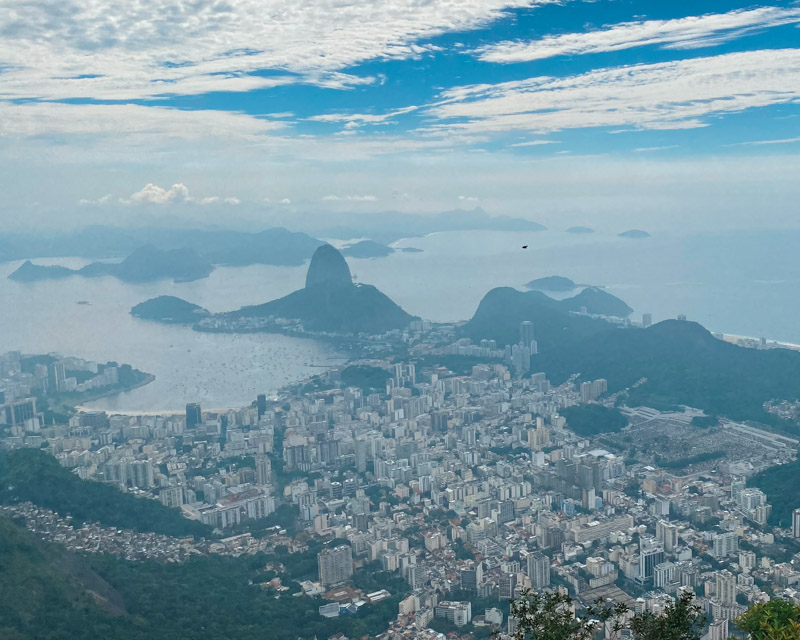
We stayed in Rio for a week and came back for another 3 nights. You can totally get lost in this city but if you follow our must-dos you can get a pretty good itinerary. We recommend you stay at least 4 nights, and the more the better.
The best time to visit is in Brazilian winter from June until September as it rains less. Be aware that the Brazilian people have their summer holidays over Christmas, New Year’s, and January so it will be crowded then. And of course, the carnival is another very busy season. But we would love to come back for that.
If you’re even more excited about South America now, check out our other South America adventures!
Blogging costs time and money. Do you want to value our work? We appreciate a tip in our virtual coffee fund at PayPal, so we can keep our website running.
Then these platforms might help you. We use them for all our travels and if you use them, too by clicking the link we earn a small fee. Yet, you don’t pay extra, but we can keep this site running. Win-win!

Welcome to the breathtaking Perito Moreno Glacier, one of Argentina’s most famous tourist attractions! The glacier is located in the Los Glaciares National Park and

Welcome to one of the world’s most awe-inspiring natural wonders, the Iguazu Falls! Nestled on the border between Argentina and Brazil, this stunning waterfall system

Come with us to El Chalten: Snow-kissed mountains, blue skies and this crazy iced-colored lagoon at the end: This is Cerro Fitz Roy. And the